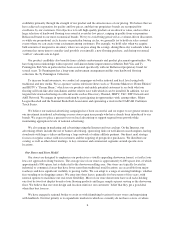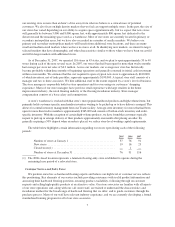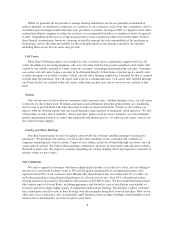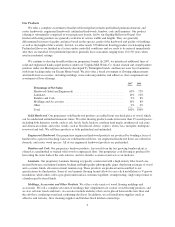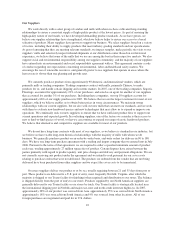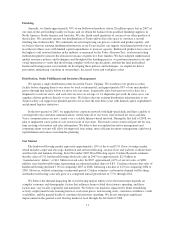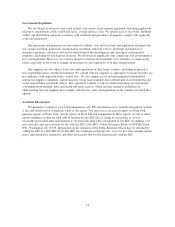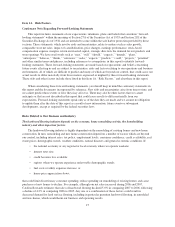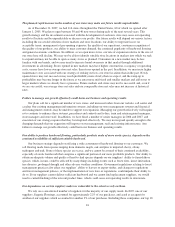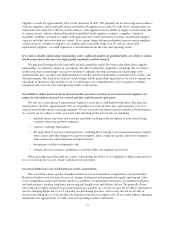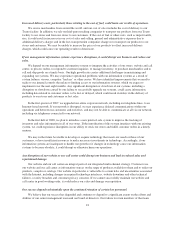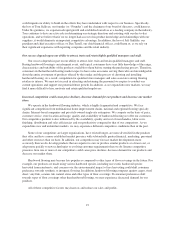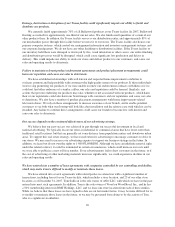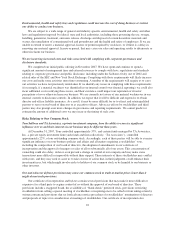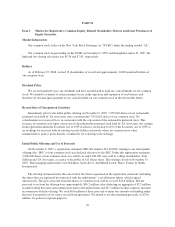Lumber Liquidators 2007 Annual Report Download - page 22
Download and view the complete annual report
Please find page 22 of the 2007 Lumber Liquidators annual report below. You can navigate through the pages in the report by either clicking on the pages listed below, or by using the keyword search tool below to find specific information within the annual report.The planned rapid increase in the number of our stores may make our future results unpredictable.
As of December 31, 2007, we had 116 stores throughout the United States, 60 of which we opened after
January 1, 2005. We plan to open between 30 and 40 new stores during each of the next several years. This
growth strategy and the investment associated with the development of each new store may cause our operating
results to fluctuate and be unpredictable or decrease our profits. Our future results will depend on various factors,
including the successful selection of new markets and store locations, our ability to negotiate leases on
acceptable terms, management of pre-opening expenses, the quality of our operations, consumer recognition of
the quality of our products, our ability to meet customer demand, the continued popularity of hardwood flooring
and general economic conditions. In addition, as we open more stores, our rate of expansion relative to the size of
our store base will decline. We may not be able to identify suitable store locations in markets into which we seek
to expand and may not be able to open as many stores as planned. Consumers in a new market may be less
familiar with our brands, and we may need to increase brand awareness in that market through additional
investments in advertising. Stores opened in new markets may have higher construction, occupancy or operating
costs, or may have lower average store net sales, than stores opened in the past. In addition, we may incur higher
maintenance costs associated with our strategy of seeking out low-cost store locations than in the past. Newly
opened stores may not succeed or may reach profitability more slowly than we expect, and the ramp-up to
profitability may become longer in the future as we enter more mid-sized and smaller markets and add stores to
larger markets where we already have a presence. Future markets and stores may not be successful and, even if
we are successful, our average store net sales and our comparable store net sales may not increase at historical
rates.
Failure to manage our growth effectively could harm our business and operating results.
Our plans call for a significant number of new stores, and increased orders from our website, call center and
catalog. Our existing management information systems, including our store management systems and financial
and management controls, may be unable to support our expansion. Managing our growth effectively will require
us to continue to enhance these systems, procedures and controls and to hire, train and retain regional managers,
store managers and store staff. In addition, we have hired a number of senior managers in 2006 and 2007, and
execution of our strategy requires that they be integrated effectively. We may not respond quickly enough to the
changing demands that our expansion will impose on our management, staff and existing infrastructure. Any
failure to manage our growth effectively could harm our business and operating results.
Our ability to produce hardwood flooring, particularly products made of more exotic species, depends on the
continued availability of sufficient suitable hardwood.
Our business strategy depends on offering a wide assortment of hardwood flooring to our customers. We
sell flooring made from species ranging from domestic maple, oak and pine to imported cherry, ebony,
mahogany and teak. Some of these species are scarce, and we cannot be assured of their continued availability,
especially of exotic hardwoods that comprise a significant portion of our more profitable products. Our ability to
obtain an adequate volume and quality of hard-to-find species depends on our suppliers’ ability to furnish those
species, which, in turn, could be affected by many things including events such as forest fires, insect infestation,
tree diseases, prolonged drought and other adverse weather conditions. Government regulations relating to forest
management practices also affect our suppliers’ ability to harvest or export timber, and changes to regulations
and forest management policies, or the implementation of new laws or regulations, could impede their ability to
do so. If our suppliers cannot deliver sufficient hardwood and we cannot find replacement suppliers, we would
need to curtail finishing of the relevant product lines, which could cause our operating results to deteriorate.
Our dependence on certain suppliers makes us vulnerable to the extent we rely on them.
We rely on a concentrated number of suppliers for the majority of our supply needs. In 2007, one of our
suppliers, Sequoia Floorings, accounted for approximately 22% of our purchases, and acted as an agent for
another of our suppliers which accounted for another 3% of our purchases. Including those companies, our top 10
16


